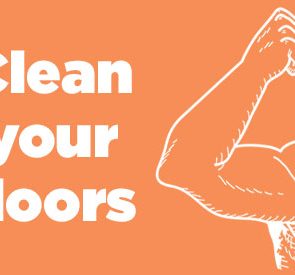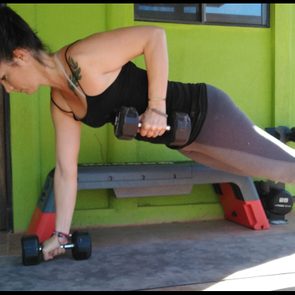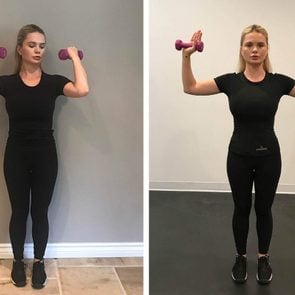4 Triceps Stretches That Really Benefit Your Upper Body
Updated: Jun. 10, 2021
Triceps stretches can help prevent more serious problems, like muscles imbalances and triceps tendinitis. Try these moves to maximize flexibility.
What do your triceps do?
If you’re looking to build or maintain upper body strength, focusing on your triceps is key to maximize your range of motion.
The triceps are a group of three muscles that run along the back of your upper arm. They originate from your shoulder blade and the large bone of your upper arm and attach to a bone in your forearm.
They are primarily responsible for extending your elbow to straighten your arm and assisting the shoulder with stabilization, extension, and adduction (moving your arms toward your body).
Functionally, whenever you push or press, the triceps engage as a helper for your chest and shoulder muscles.
(Try these chest stretches, too.)
Why your triceps might become tight
Of all the muscles in your body, the triceps generally aren’t known for tightness or related problems. But that doesn’t mean they can’t get tight.
“There are different reasons for triceps muscles to become tight. For instance, if you’ve undergone a strenuous exercise program, it’s likely due to muscle hypertrophy, or muscle growth,” says Ahmed Helmy, MD, plastic surgeon, sports science specialist, and editor for Calisthenics-Gear.com.
Do a lot of push-ups, dips, and overhead triceps extensions, and you may end up with tight triceps. But that’s not the only reason you may be feeling tightness in the area.
“Tight triceps can also be caused by repetitive motions that involve straightening the arm and overuse in activities like throwing or hammering,” says Alissa Tucker, a certified personal trainer and master trainer at AKT, a dance-based workout studio.
What’s the big deal with tight triceps?
Think twice before skipping triceps stretches after your next workout. Just like any other muscle group, your triceps can get sore or overworked. When that happens, you may notice a limited range of motion and other problems.
Even if you’re not experiencing obviously negative outcomes from a set of tight triceps, your limited range of motion in this muscle group may be causing problems.
“Continuing to exercise with tight triceps may lead to impaired movement patterns in other exercises due to not fully straightening the elbows,” says Tucker.
In other words, even if you’re not in pain, tight triceps can mess up how well you do some strength-training moves.
“For example, when doing a biceps curl, your body might compensate for tight triceps by keeping a micro bend in the elbow, which inhibits you from getting a full eccentric [lengthening] contraction of the biceps,” she says. “In the long run, this can result in further muscle imbalances.”
And if you’re not careful, these muscle imbalances can lead to pain and injuries.
Don’t overlook triceps tendinitis or other serious injuries
When your triceps are chronically overused or tight, both Dr. Helmy and Tucker point to triceps tendinitis as a potentially negative outcome (although it’s certainly not the only one).
“Strains can happen, which can lead to swelling and painful symptoms,” says Dr. Helmy, “And you need to consider triceps tendinitis as a potential factor behind tightness, too.”
But you won’t feel triceps tendinitis, inflammation of the triceps tendon, directly in your triceps. Rather, you’ll typically feel it as pain in your shoulder or elbow (the areas where the triceps attach).
“Failure to attend to causes can lead to more severe damage, making it more difficult to treat in the future,” says Dr. Helmy.
This is why it’s so important to see a doctor or physical therapist if pain, tightness, or limited range of motion at the elbow or shoulder persist.
“Chronic stiffness may be a sign of a serious injury,” Helmy says, noting that stiffness can happen if a tendon is torn or partially torn away from the bone.
(Don’t forget to stretch your rounded shoulders.)
Triceps stretches to ease tightness
Stretching regularly can help prevent limitations in range of motion and help ease tightness. And triceps stretches are easy to perform, so there’s no reason to ignore this simple solution to help maintain mobility and work to prevent future problems.
Consider adding the following stretches, suggested by Dr. Helmy and Tucker, to your workout regimen.
(Here’s how to get stronger arms.)
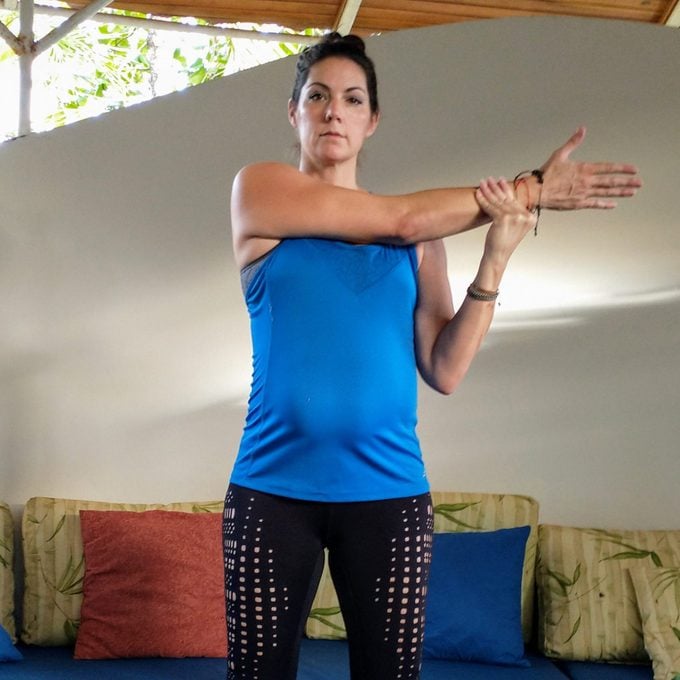
Cross-body triceps and shoulder stretch
Stand tall with your feet roughly shoulder width apart.
Check your posture to make sure your shoulders are back and your ears are roughly aligned with your shoulders, hips, and knees.
Lift your right arm to shoulder height, then bring it across your body, in front of your chest.
Use your left hand to grab your right arm right below the elbow to continue drawing your right arm across your chest until you feel a stretch in your triceps and the back of your shoulder.
Hold the position for 20 to 30 seconds before releasing.
Complete three sets before switching arms.
(For back pain, try these stretches for the upper back.)
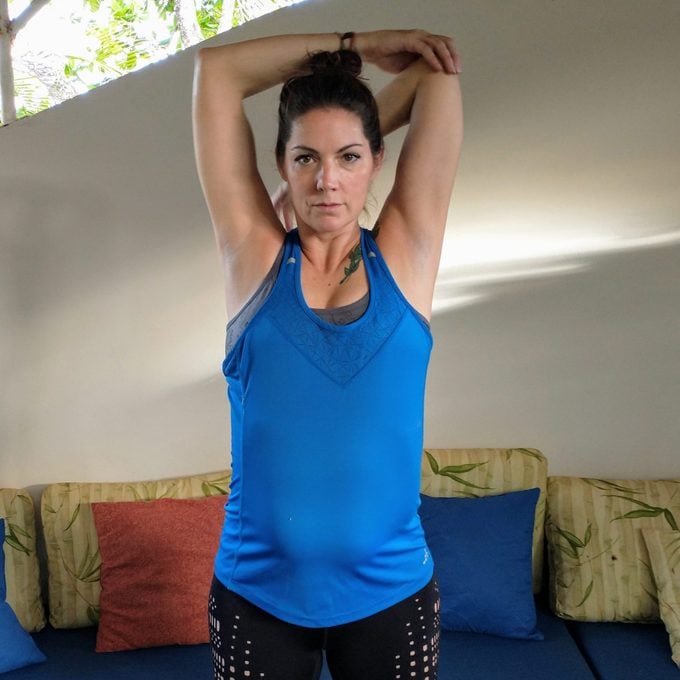
Overhead triceps stretch
The overhead triceps stretch specifically targets the triceps.
Start by standing tall with good posture, your feet roughly hip distance apart.
Reach your right arm straight up overhead. Bend your elbow and reach your right hand down the center of your back.
With your left hand, grasp the outside of your right elbow. Gently push your right elbow back, helping your right hand reach further down the center of your back.
Stop when you feel a good stretch of your right triceps. Hold the position for 20 to 30 seconds before releasing.
Complete three sets before switching arms.
(Follow these tips to help lose your arm fat.)
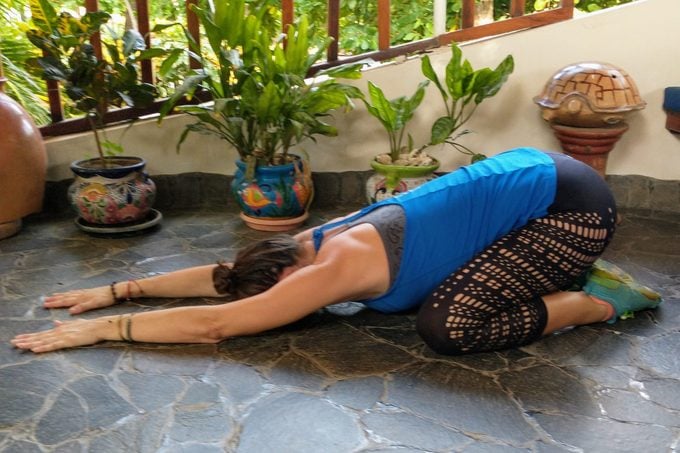
Child’s pose
Child’s pose is an excellent way to relax into a light triceps stretch while also stretching your chest, low back, hips, and even your ankles.
You can include it as part of an active warm-up, incorporating the pose into a sun salutation or other dynamic stretches. Or you can use it as part of your cooldown after a workout.
Start in a kneeling position with your feet together and knees roughly hip distance apart. Sit back on your heels.
Check your posture: roll your shoulders back and sit up straight, engaging your core.
Lean your torso forward over your thighs. Extend your arms straight overhead, pressing your palms into the floor.
You should feel a stretch along your triceps, shoulders, and chest, as well as through your low back and hips. If you don’t feel a stretch, spread your knees a little wider to allow your torso to lean farther forward between your legs.
When you feel a good stretch, stop and hold the position for 30 to 60 seconds. Repeat two to three times.
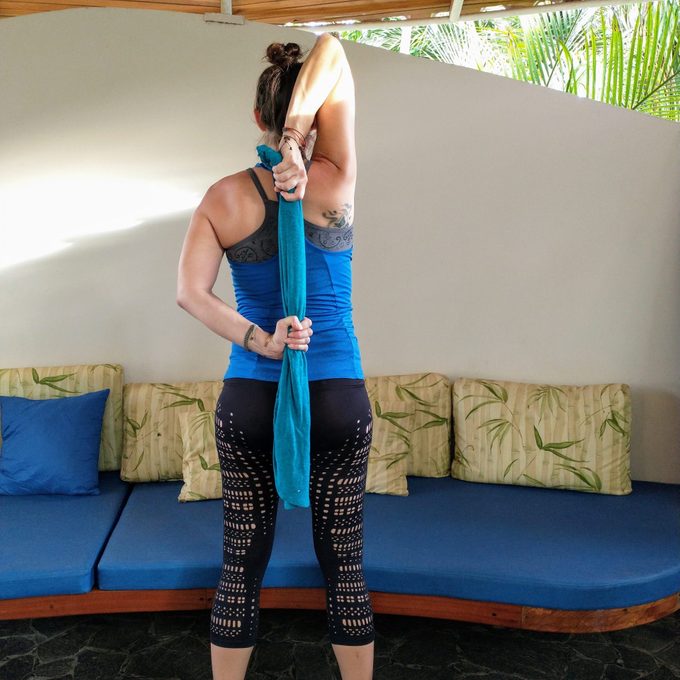
Towel triceps stretch
If you have particularly tight triceps and shoulders, the towel stretch can help you slowly work on your mobility.
You’ll start by standing tall with good posture. Keep your feet roughly hip distance apart.
Hold a towel or belt in your right hand and extend your right hand overhead. Find a position that works for you based on your own shoulder flexibility. Allow the towel to hang behind your back.
Reach your left hand behind your back to grasp the opposite end of the towel. If the towel is long, try to grasp it at roughly mid-back level (if your flexibility allows).
From here, pull down on the towel with your left hand (as if you were drawing a line down the center of your spine), which will draw your right hand farther down your back, your right elbow closer to your right ear.
Stop when you feel a stretch in your right triceps. Hold the position for 20 to 30 seconds.
Complete three sets before switching arms.


















